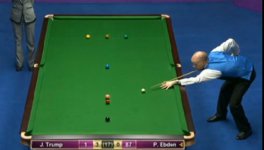Without "cocking" the wrist you have to supply more power with your arm
This is very good, and I would suggest you experiment with cocking your cue up a few inches (even if you cock the cue up two feet you still want to come down with your cue at the same angle as you have it here) so when you go through the ball your elbow/shoulder will stay more stable. Without "cocking" the wrist you have to supply more power with your arm which effects your simplicity of the motion. imho.
So I know this thread is getting off track somewhat, but in the interest of posting something relevant to the title, this is a quick video I made of the grip and stroke I have been using for a few weeks now. This is not an attempt to 'try' CJs method, but rather I read this post and realized that the grip I thought I had 'discovered' was very similar to what CJ described as his.
Does this look like what CJ is describing?
This is very good, and I would suggest you experiment with cocking your cue up a few inches (even if you cock the cue up two feet you still want to come down with your cue at the same angle as you have it here) so when you go through the ball your elbow/shoulder will stay more stable. Without "cocking" the wrist you have to supply more power with your arm which effects your simplicity of the motion. imho.
